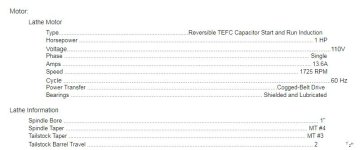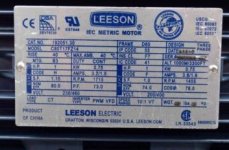npalen
Elite Member
Attached are the motor specs for my Grizzly G0602 metal lathe which is listed as 1.0 HP. I'm trying to understand why the amperage shown is so high. Testing the draw with an amprobe shows about 8.0 amps under no load and about 11.0 amps under as much load as I could put on it with a turning tool.
Looking at other 1.0 HP motors on the web, I see that 8.0 amps, give or take is typical of that size motor. I get the feeling that this motor should be rated at closer to 2.0 HP based on the higher amperage rating. Please help me understand the difference.
The reason I'm questioning this is looking at replacing the single phase motor with a three phase and VFD to get variable speed, reversing etc.

Looking at other 1.0 HP motors on the web, I see that 8.0 amps, give or take is typical of that size motor. I get the feeling that this motor should be rated at closer to 2.0 HP based on the higher amperage rating. Please help me understand the difference.
The reason I'm questioning this is looking at replacing the single phase motor with a three phase and VFD to get variable speed, reversing etc.

